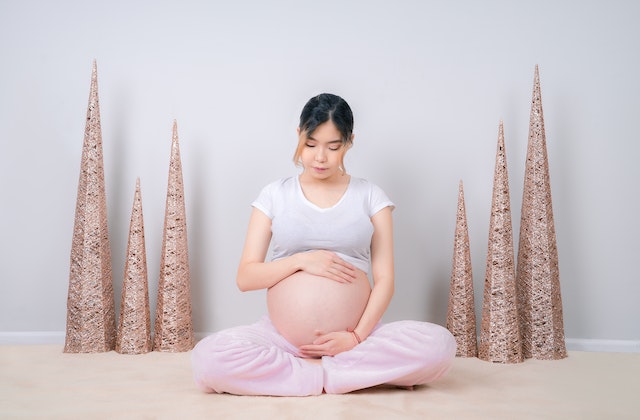
Back pain is a common complaint during pregnancy, particularly in the early stages. This is because the ligaments in your body naturally soften and stretch to prepare for labor. As a result, the joints in your lower back and pelvis can be strained, leading to discomfort. So, can you crack your back while pregnant?
Cracking your back can be a satisfying and relaxing experience for many people. However, it may become more challenging to do as your pregnancy progresses. It’s important to be careful and avoid any sudden or jerky movements that could cause further strain on your back or harm your growing baby.
It’s generally safe to crack your back during pregnancy if done carefully and with the guidance of a healthcare professional. However, if you have any concerns or underlying medical conditions, it’s always best to consult with your doctor before attempting any new form of pain relief.
Why Your Back Cracks

Similar to your back, the joints in your neck, shoulders, and fingers can also crack or pop. This sound is caused by air bubbles in the synovial fluid that surrounds and lubricates your joints. When you stretch or twist your spine, pressure is put on this fluid, and the release of nitrogen, oxygen, and carbon dioxide from the facet joints causes the popping sound.
Joints, tendons, and ligaments can also make a snapping noise when pushed in and out of their initial positions. Additionally, arthritic joints may produce grinding noises due to the loss of cartilage.
Can You Crack Your Back While Pregnant
Although it is generally safe to crack your back while pregnant, there are many myths and misconceptions concerning the possible negative repercussions of breaking any bone in your body.
Some pregnant women find physical and even psychological relief from cracking their backs, and this impulse doesn’t go away when they get pregnant. When their back cracks, they immediately feel a release, and the cracking sound quickly calms them.
So, is it safe to crack your back while expecting? The short answer is yes, provided everything is done properly and you don’t have any medical conditions that would prevent you from doing so.
However, it is important to be mindful that any back pain you experience could be caused by your baby’s weight and position. As your pregnancy progresses, it could become more difficult to crack your back.
To avoid any health issues that could cause discomfort or spinal pain, it is recommended that you seek the services of a certified chiropractor or a practitioner who has received training at a chiropractic clinic rather than attempting to crack your back on your own.
Is It Bad To Crack Your Back While Pregnant

Cracking your back does not necessarily indicate that you have damaged or twisted internal organs. The sound you hear is often known as Crepitus, which occurs when gas or air is transferred between the joints.
The release of nitrogen, oxygen, and carbon dioxide from the facet joints helps to lubricate them, alleviating the pressure.
While cracking your back is typically safe during pregnancy, it’s critical not to apply too much force or overdo it.
If you have vaginal bleeding, ectopic pregnancy (a condition where the egg implants outside of the uterus), or toxemia (a condition marked by high blood pressure and proteins in the urine), your doctor may advise you to avoid cracking your back.
If you’re experiencing a lot of strain, discomfort, or pain in your back during pregnancy, it may be due to the weight distribution. Visiting a doctor or receiving chiropractic care is recommended if you frequently feel the need to crack your back while pregnant.
What Triggers Back Pain

What then causes my back pain during pregnancy?
1. Gaining weight
Women normally gain between 25 and 35 pounds during a healthy pregnancy. That weight must be supported by the spine. That might result in lower back pain. The blood arteries and nerves in the pelvis and back are additionally compressed by the weight of the uterus and the developing baby.
2. Posture changes
Your center of gravity is changed by pregnancy. As a result, you might start to gradually — even without realizing it — change your posture and movement. Back pain or strain could occur from this.
3. Hormonal changes
Your body produces the hormone relaxin during pregnancy, which permits ligaments in the pelvic region to loosen up and joints to relax in preparation for labor. The same hormone can make the ligaments supporting the spine lax, which causes instability and discomfort.
4. Muscle separation
The rectus abdominis muscles, which run in two parallel sheets from the rib cage to the pubic bone, may split down the middle as the uterus grows. The separation could make back pain worse.
5. Stress
Back soreness or back strains can result from emotional stress causing muscle tension in the back. During your pregnancy’s difficult times, you may notice that your back ache gets worse. If back pain is related to stress, talk to a therapist or counselor, it may be helpful.
You may also experience pain due to;
- Lengthy and busy days
- The bulging stomach
- Wearing high heels
- Having to spend a lot of time driving and moving around.
When You Should Not Crack Your Back
If you crack your back incorrectly or too frequently, problems could arise. If you have a disc problem, are healing from an accident, or are in any discomfort or edema, avoid cracking your back.
After a joint has been cracked, it takes roughly 20 minutes for it to be ready for another crack. The joint has time to go back to its initial position as a result. During this time, avoid cracking your back since you risk tearing the ligaments. It should not be necessary to continuously crack your back.
How To Manage Back Pain During Pregnancy

In pregnancy, releasing stress should be done carefully, gently, and cautiously. It will stop the problem from getting worse or resulting in any back damage.
You can attempt the body twist, the upward stretch, or any of these techniques to treat back pain during pregnancy.
1. Pregnant yoga
You can begin prenatal yoga classes at any point throughout your pregnancy.
It helps you emotionally get ready for labor while also providing back pain relief.
Several breathing and relaxation techniques designed especially for pregnant women are included in pregnancy yoga. However, always get the go-ahead from your doctor before beginning a course.
2. Maintain proper posture.
Adopting excellent posture can help reduce back pain. Women who are expecting often lean back to make up for the weight of their growing baby. Therefore, pay attention to how you move, sit, and stand.
3. Proper sleeping position
Sleeping during pregnancy can be challenging because the wrong position might lead to increased physical aches. The best position to sleep in when a pillow is placed between your knees is on your side.
As it might become painful for both you and the baby, avoid sleeping on your back. Additionally, memory foam pregnancy pillows are an option for extra support as you sleep.
4. Wear the appropriate footwear
Basically, footwear either makes pregnancy more comfortable or more difficult. Avoid wearing unstable high heels; that much is obvious. However, flat shoes might not offer you the best support either.
The feet will become more dispersed and unsupported as a result. When expecting, select shoes with low heels because they better support the body’s arches.
5. Swimming
Swimming is a fantastic and risk-free type of exercise that can aid in relieving pressure on the spine. It strengthens the body without placing undue strain on you or the unborn child.
You might even begin swimming after you give birth. Always exercise moderately and refrain from exerting yourself excessively.
You should try to swim three to five times per week for roughly 30 minutes.
6. Acupuncture
Acupuncture is a type of Chinese medicine. To perform acupuncture, small needles are put into certain points on your skin. Acupuncture has been found in studies to be useful in treating low back pain in pregnant women. If you’re interested in giving it a try, consult your doctor first.
7. Physical exercise
Despite being pregnant, you shouldn’t avoid doing anything. Regular exercise can help avoid back pain.
Recommended Exercises You Can Try.
8. Pelvic Tilts
The simplest approach to learning the pelvic tilt is to lie on your back with your knees bent and your feet flat on the ground. You’ll probably feel a gap between your back and the floor if you put your palm on the small of your back.
To feel no space between your back and the floor, try to flatten the lowest section of your spine against it. To isolate the abdominals, the buttocks should be relaxed. You can tilt your pelvis while sitting, standing, on your hands and knees, or sleeping on your back.
9. Arm and Leg raises
Kneel on your hands and knees with a straight spine to perform arm and leg raises (for the back and buttocks). Lift your right arm and left leg to make a straight line with your spine, then tilt your pelvis to hold it in place.
After pausing in this position, slowly extend your arm and leg. Lift the opposing arm and leg alternately. If maintaining your balance in this posture is challenging for you, adapt the exercise by focusing only on the leg or arm raises.
It is recommended that the strengthening exercises be carried out slowly and steadily.
You can hold the poses for 3 to 10 seconds and do them 10 to 30 times. When you are working out, exhale, and when you are relaxing, inhale.
9. Chiropractic Care During Pregnancy
If you have no experience with chiropractic, you may be scared to try it out during pregnancy. Chiropractic care especially when pregnant sounds dangerous.
You may be thinking that you have no experience with chiropractic care. “How can I crack my back during pregnancy without getting hurt?”
First off, receiving chiropractic care entails more than just back cracking.
Secondly, although certain chiropractors specialize in treating pregnant patients all of them have the necessary training.
The American Pregnancy Association says that there are no known risks associated with receiving chiropractic care while pregnant, and practitioners who have received special training in working with expectant patients may use tables designed for a pregnant woman’s body and employ procedures that prevent unnecessary pressure on the abdomen.
In addition to helping with back pain, the American Pregnancy Association advises that chiropractic can help with other pregnancy-related issues such as:
- Maintaining a healthier pregnancy
- Controlling symptoms of nausea
- Reducing the time of labor and delivery
- Relieving back, neck or joint pain
- Preventing a potential cesarean delivery
When To Worry About Back Pain
Call your doctor if you have a fever, pain beneath your ribcage, or severe back pain that lasts for two weeks.
If you experience painful urination and vaginal bleeding, you should also get in touch with them. In the second and third trimesters, severe back pain may indicate early labor.
Takeaway
During pregnancy, it’s best to avoid rigorous activities such as twisting, bending, squatting, and lifting repeatedly to reduce the risk of harm, miscarriage, and premature birth. Moderation is key, and if your back cracking causes discomfort, it’s best to stop.
If done correctly, cracking your back can be a safe way to relieve back discomfort, whether you’re pregnant or not. However, it’s important to exercise caution and avoid repeatedly cracking your back, forcing it into positions, or applying excessive pressure.
To support a healthy spine, apply ice and heat to the affected area as needed, and perform stretches and exercises. If your symptoms persist, make an appointment with a doctor or physical therapist.
It’s important to seek medical advice before starting any exercise routine or trying to manage your discomfort. Your doctor can provide you with the safest ways to relieve back pain during pregnancy. Remember that back pain during pregnancy is normal and can be managed with proper care and exercise.
Leave a Reply
You must be logged in to post a comment.